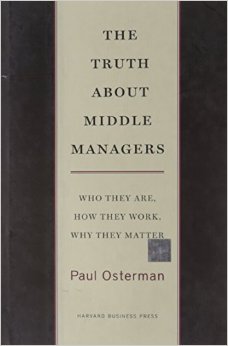by Paul Osterman., Boston: Harvard Business School Publishing Corporation, 2008. 171 pages.
Reviewed by Diane Byington, Ph.D.
Paul Osterman brings his academic perspective from the MIT Sloan School of Management to the issue of what is happening with middle managers today. Basically, he finds that middle managers are insecure in their jobs, more loyal to their teams than to the larger corporation, and like the work they do. None of these conclusions will be a surprise to people who work within corporations, but the data-driven analysis gives his words some weight.
One of the most intriguing discussions in his book is the history and perceptions of middle managers in the overall culture. Early in the twentieth century, advances in technology permitted cheap production on a very large scale. Middle management was the key actor that facilitated the remarkable growth and efficiency of the American economy. Without middle management’s coordination of production and distribution, firms could not grow big enough to take advantage of the technological potential of mass production and low unit cost. In other words, middle managers were heroes at first.
The hero image gave way in mid-century to the Organization Man, whose careers were stable (or boring, as popular books and movies represented) and predictable in the rise to executive positions. Since the 1980s middle managers have been viewed as dysfunctional: using up too many resources and an obstacle to efficient production. This critique of middle management is widely used to justify the elimination of middle management positions.
The current view of middle managers is that they are “intrapreneurs,” changing jobs frequently and working across the boundaries of small networked companies. Osterman doesn’t find much support for this perception in his data. In spite of downsizing and delayering, the percentage of the labor force that is managerial has shown a small but steady increase over time. Many firms may be laying off managers, but evidently, other firms are hiring them to take up the slack. They often job-hop within a division or an organization, but overall, they enjoy relative employment stability, even though the threat of lay-offs is eternally present. Not surprisingly, since the year 2000, the median pay of managers has stagnated.
The role of middle management has changed over time. No surprise: teams are more important today than they used to be, and middle managers coordinate the work of teams and mediate between teams. The continuous organizational turmoil that exists in today’s organizations creates an environment that seems chaotic and out of control from the perspective of middle management. Accordingly, stress is rampant. Middle managers don’t climb the ladder into executive positions as often as in the past. Increasingly, executives are brought in from outside, so career paths for middle managers are often limited.
Osterman views middle managers today as craft workers – the work is intrinsically interesting, there are opportunities to use existing skills and learn new ones, work is an end as well as a means, and the work is an important component of personal identity. Regardless of how they feel about the changes in the larger environment, most middle managers are committed to their work and to their teams. They are not, however, loyal to the top executives, whom many consider to be self-serving and greedy. They are focused on their day-to-day jobs and are thinking about what they will do if laid off.
The big challenges for middle managers are how to overcome alienation and how to build careers when there are fewer rungs on the ladder. The author recommends that career paths need to be built that do not rest entirely on upward mobility and that expose managers to a broader view of the enterprise. This might be accomplished by encouraging more horizontal movement across positions and increasing internal training opportunities. Public policy has a role, too. Health insurance should be decoupled from employers and laid off managers should be assisted to find new jobs. Fairness is an issue that should be addressed, specifically in the area of executive versus other workers’ salaries. In addition, corporations need to remember that their employees’ interests are important, not just those of shareholders.
The book is an interesting read. One concern I have, though, is his definition of middle managers. These include anybody not in an executive position whose job description includes supervising others. In my mind, this would also include first-line managers, so his understanding of middle management is broader than mine might be. Also, it is written in an academic style, befitting an academic, and, while enlightening, isn’t always an easy read. But worth it, if you are a middle manager and want to know if what you are experiencing is shared by others.
— Diane Byington is a writer and coach who consults with The Booth Company.

